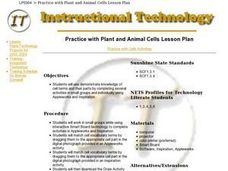Curated OER
Click it! See it! Say it!
Scholars take digital photographs of a phonic cluster. Each child will use their digital pictures in a PowerPoint slide with text showing the sound and the word that contains that sound. Then they will take a picture of the object they...
Curated OER
How Cells Reproduce
Learners explain why cells reproduce and draw a diagram of each of the stages in mitosis. They put the stages of mitosis (interphase, prophase, metaphase, anaphase, telophase, and cytokinesis) in the correct sequence, from the beginning...
Curated OER
Angle Pairs
Eighth graders are introduced to the vocabulary associated with angles. They experiment with vertical angles, alternate interior angles, alternate exterior angles, and corresponding angles. They determine angle pair relationships when...
Curated OER
The Industrial Revolution
Tenth graders analyze the impact (costs/benefits) of the Industrial Revolution on various groups of people in society (gender, children, socio-economic class, etc.). They then evaluate the impact of industrialization on the environment.
Curated OER
The Pythagorean Theorem
Students research Pythagoras and learn how to apply his theorem. They solve real life problems using the theorem and demonstrate knowledge of exponents, equations, and radicals. Students include diagrams in their research papers.
Curated OER
Immigration Push and Pull Factors
Eighth graders explore the definitions for push and pull factors and determine whether reasons for immigration are considered push or pull factors. They then determine their own reasons for immigration and categorize them.
Curated OER
Literary Terms Used in I, Juan de Pareja
Seventh graders define six different literary terms after reading I, Juan de Pareja. In groups, they are given a specific literary term to create a PowerPoint presentation explaining how their term in utilized in the context of I, Juan...
Curated OER
Pythagorean Theorem
Pupils solve problems using the Pythagorean Theorem. In this geometry lesson,students identify the right angle, hypotenuse and legs of a right triangle. They find the missing sides using the ratios of the Pythagorean theorem.
Curated OER
Practice with Plant and Animal Cells
Students work in small groups to match cell vocabulary terms to the appropriate cell part in a photograph. They use a draw program to sketch a plant and animal cell.
Curated OER
Teaching Lewis and Clark: Why Fort Clatsop?
Students study the path Lewis and Clark took on their famous trans-American journey. They participate in an online activity that allows them to examine considerations the Expedition made when deciding where to spend the winter of 1805-06.
Curated OER
Sacred Places: California Missions from Different Perspectives
Students create a project poster displaying photos, drawings, and journal writings that incorporate the major themes of California's missions, and use perspective and point of view both visually and in writing.
Curated OER
KWL Chart
In this KWL chart worksheet, students fill out a graphic organizer about what they know, what they want to know, and what they learned about a given subject.











